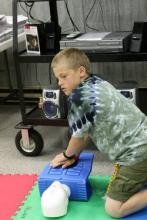Cardiopulmonary resuscitation training should be a requirement for graduation from high school and should include instruction on the purpose of an automated external defibrillator and how to use one, according to an American Heart Association consensus statement released Jan. 10.
The science advisory statement, developed in collaboration with the American Academy of Pediatrics and the American College of Emergency Physicians and published in the journal Circulation, also recommends that students have opportunities to practice and master psychomotor skills related to CPR, since trainees do not learn enough unless they get the chance to practice.
Although secondary school students most likely won’t encounter a victim of cardiac arrest at school, they may encounter one elsewhere in the community, and teaching CPR skills early can lead to more proficiency later, the AHA statement said.
"Increasing the percentage of the population trained in CPR is an integral part of an overall strategy to improve community response" to out-of-hospital cardiac arrests, the statement said. "Schools provide excellent access to a large part of the community. ... Therefore, over time, a significant percentage of the overall community will receive training."
In 2003, the International Liaison Committee on Resuscitation recommended that CPR instruction be incorporated into standard school curriculums, and the next year the AHA recommended that schools train all teachers in CPR and first aid and train all students in CPR in order to prepare for potential medical emergencies on campus.
As of the 2009-2010 school year, laws or curriculum standards in six states require CPR training as a component of mandatory health education, while 30 states encourage schools to teach CPR, according to the AHA statement. However, implementation of these laws isn’t uniform, and not all schools teach CPR, even in states that have the strongest language encouraging such training, the AHA statement said.
Therefore, requiring CPR training as a condition of high school graduation would significantly increase the level of CPR knowledge in the community over time, the statement said, adding, "the evidence shows that previous training, at any interval before there is a need to use the skills learned, will increase the likelihood that a bystander will provide appropriate care to a victim."
It’s critical to target the correct age group for training, the AHA statement said. Students younger than about 13 years old may not have the necessary physical strength to perform correct chest compressions. Therefore, "it is reasonable to limit practice of adult CPR chest compression skills to children in middle school (around 13 years old) and older," the statement said (Circulation 2011;123:[doi: 10.1161/CIR.0b013e31820b5328]).
Programs designed for schools should include the core skills of conventional CPR and hands-only CPR developed by the AHA, and should emphasize recognition of the emergency and provision of high-quality chest compressions, the statement said.
The statement does not urge mandatory automated external defibrillator (AED) skills practice, although it recommends that schools providing AED skills practice give students an opportunity to practice and master all steps of CPR and AED use, with special emphasis on minimal interruptions in performance of CPR, correct application of pads to an appropriate surrogate for the human thorax, and proper "clearing" of the patient when so instructed by the AED.
Schools have cited a lack of available class time as a barrier to implementing CPR instruction. However, it should be possible for schools to implement such training as part of health courses or as part of a "community service" requirement for high school graduation, the AHA said. In addition, schools can make use of video-based, self-directed training programs and online or other e-learning programs, the statement said.
Several members of the writing committee had relationships that the AHA deemed significant: Dr. Tom P. Aufderheide of the Medical College of Wisconsin, Milwaukee, has received research support from Zoll Medical and Advanced Circulatory Inc.; and has served as an advisor or consultant to Medtronic and JoLife Inc.; Dr. Keith Lurie of the University of Wisconsin is also founder and chief medical officer of Advanced Circulatory Systems, as well as the inventor of that company’s ResQPOD. Dr. Vincent N. Mosesso Jr. of the University of Pittsburgh has received research support from Zoll Medical.

